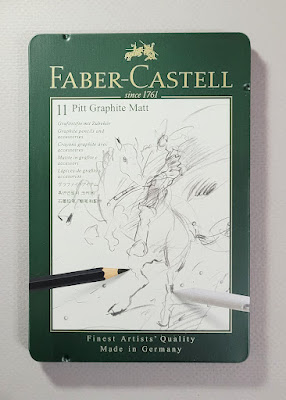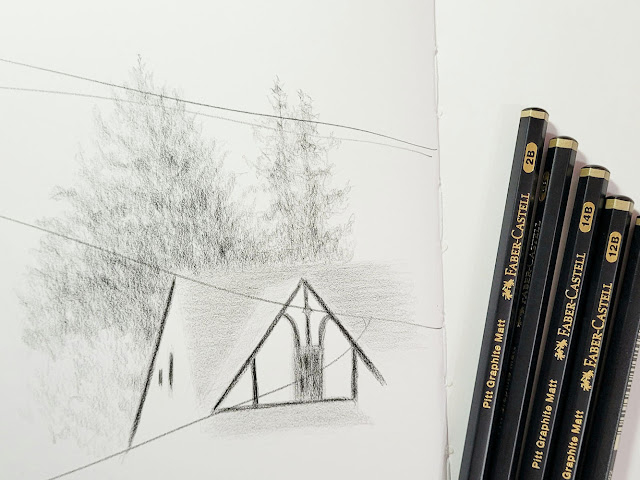 |
| Faber-Castell's innovative Pitt Graphite Matt pencils |
Those of us who hang out in the pencil world see many, many
graphite pencils come and go with different colors and designs on the outside.
It’s a rare occasion, however, when a pencil manufacturer releases a new product
with a genuinely new type of graphite core on the inside. It was, therefore,
with much anticipation and excitement that I tried a set of Faber-Castell’s new Pitt Graphite Matt pencils.
Anyone who has applied a heavy area with graphite has seen the silvery reflection that results. As long as a drawing is viewed without direct illumination, the graphite appears dark, but when tilted toward the light, the shiny reflection changes its appearance significantly. I find this reflective characteristic annoying even while I am drawing if the paper is flat on the desktop and a light is shining directly over it. (It’s one reason I find the Art Stand Desktop Easel essential.)
According to Faber-Castell, Pitt Graphite Matt (I’m using the German spelling that is used on the product tin), a “revolution” in graphite drawing, “was specially developed to reduce light reflections on the paper.”
Available in eight grades – HB and even grades through 14B – the German-made Matt pencils come in a set of six (missing HB and 14B) and a set of all eight with an eraser, sharpener and blending stump. Blick also sells them open stock.
 |
| Available in 8 grades |
 |
| 11/22/21 Pitt Graphite Matt pencils (HB, 2B, 6B, 12B, 14B) in Stillman & Birn Zeta sketchbook |
My first impression was that all the grades I used (HB, 2B, 6B, 12B, 14B) seemed much lighter than other pencils of comparable grades. I’m used to and sketch most often with Japanese pencils (Mitsubishi Hi-Uni being my favorite), which are consistently softer and darker than other pencils, but I’m not unfamiliar with Staedtler, Faber-Castell and other European brands. The Matts also felt different – smoother than Faber-Castell’s Castell 9000, for example, though not in a Japanese-smooth-graphite kind of way (how’s that for articulate and unbiased commentary?). As promised, however, the areas of darkest application in my sketch showed very little reflection.
Faber-Castell is not forthcoming in marketing information about what the graphite is mixed with to impart its revolutionary matt appearance, so I wondered if it could be some form of carbon, like Staedtler’s Mars Lumograph Black. Now that I have the Matt pencils in hand, however, I don’t think it’s carbon at all: The material looks and especially feels very different.
It was time for some testing and comparisons. First I made swatches with the Matts in each grade and Faber-Castell 9000, Staedtler Mars Lumograph and Mars Lumograph Black, and Mitsubishi Hi-Uni in comparable grades (as available in my studio). As I thought, the Matts are lighter than all the other pencils in comparable grades, even F-C’s own Castell 9000.
The Matt’s 14B grade, which may be unprecedented as a graphite grade, is unremarkable in darkness: It’s certainly lighter than the Mars Lumograph in 12B and Hi-Uni 10B.
More significant is the comparison for reflection. Below are the same five pencils with several layers of 4B. The top image was photographed to avoid reflective light. The lower photo shows the page tilted toward my desk lamp. Only the Mars Lumograph Black remains as matte as the Matt. (Apologies for the fuzzy focus – tilting the page to catch the light confused my phone’s camera.)

Swatches without direct lighting
 |
| Page tilted to reflect light |
Equally interesting is the smudge test. I don’t typically test graphite for smudginess since I assume all graphite pencils are prone to smudging. But while I was making the initial sketch, I inadvertently smeared a thumb across part of the drawing and was surprised that it didn’t smudge as expected. I thought it would be worthwhile to compare this characteristic. Indeed, using one clean finger to make each smudge, the Matt smears the least. I repeated the test using the blending stump that came with my set and had the same results. I’d say this reduced smudging property is a notable benefit that Faber-Castell doesn’t even mention in its marketing information!
 |
| Top row smudged with finger; bottom row smudged with blending stump |
 |
| Erasing with a Tombow Mono Zero was average. |
Do I love the Matts? Not really. Although I do appreciate their non-reflective property as well as their lower smudginess, I’m not crazy about the way they feel. (Yes, yes, I know I’m spoiled by that Hi-Uni silky-smoothness. So sue me.) But as I was making the swatches, a light bulb snapped on over my head: The non-reflective quality only matters on the final application of graphite. Perhaps I could make most of a drawing with my favorite Hi-Unis, then apply the Matts as a final layer over the areas most heavily covered with graphite and therefore most reflective. Would it work?
The test result is below: At left is a swatch of heavily applied Hi-Uni 4B. At right is a similar swatch of Hi-Uni, but as a final layer, I applied a Matt 4B. I tilted the page toward my lamp to photograph it.
 |
| Two swatches of Hi-Uni 4B; the one at right has a final layer of Matt 4B |
A-ha! It’s possible to take advantage of the Matt’s non-reflective quality without having to use the pencil for the entire drawing. Which I will be doing!
Whatever the Matt’s secret ingredient, Faber-Castell has definitely created an innovative, unique pencil.



Very much appreciate your review on these pencils as I saw them on your Instagram the other day and was intrigued, then found that there is so little information out there on these at them moment, being such a new product. I've been waiting for a written review as I hate watching video reviews. Definitely sound useful for certain applications, but maybe in a few select grades rather than the full range. I've been holding off on the Mitsubishi Hi-Uni, but might have to try them out sooner than later. 😅
ReplyDeleteReally enjoy your reviews!
Thanks for reading! Glad I could be of service!
DeleteGreat, and complete review, Tina. Thanks. While I like the notion of a graphite pencil that smudges less, like you I'm a fan of Japanese pencils. I won't be giving up my Mono100s anytime soon.
ReplyDeleteIt's hard to use anything after you've been spoiled by Japanese graphite! ;-)
DeleteSo you would say these are more of a niche tool to be had fun with rather than the graphite day to day workhorse?
ReplyDeleteThese could definitely be a daily workhorse if you prefer harder and lighter graphite (grade for grade). If someone were used to European graphite, it would be an easy transition, and these have definite benefits over ordinary graphite. But I love my Hi-Unis too much. ;-)
DeleteThank you so much for your detailed review. I had every question you did and use the staedler Mars both regular and black as well as the Hi-Uni. All 3 are my fave to use. I really wanted to try these and I would have never thought to add the final layer with them but seeing the result from your brilliant idea I am sold for trying them. I have used the Mars black for a final layer but sometimes the carbon in them can stain and does not erase should I make a mistake and then I have to do some serious altering which annoys me. Again, thank you.
ReplyDeleteHappy to hear that my review was helpful! :-)
Delete